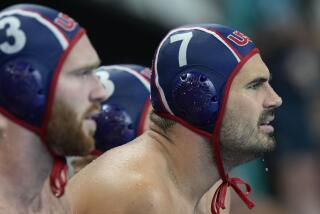United States Team Poised to Raise Its Gold Standard
- Share via
NAGANO, Japan — There was a time when the United States used to be a winter sports wimp, last in luge, behind in biathlon and nowhere to be found in Nordic combined.
But as the 1998 Olympics began with opening ceremonies beamed live Friday night to the United States, the American team could be considered among the winter sports elite.
If it’s made-for-television or dominated by pros, then there must be Americans chasing for golds.
These are the Games of teen-age figure skating stars Michelle Kwan and Tara Lipinski, of National Hockey League millionaires named Brett Hull and Mike Richter and of a band of wild-and-wacky daredevils out to show that America is No. 1 in snowboarding.
The United States appears poised to claim its biggest batch of medals in Winter Games history, perhaps topping 20.
And a snowboarder is out to become America’s first “golden dude.”
“I’m in position to get the ball rolling for the U.S.,” said Chris Klug, who will speed down a snowboard giant slalom course on the first full day of Olympic competition.
The Americans are trying to use these Games as a launching pad for the 2002 Olympics to be staged in Salt Lake City. By then, the Americans may be nearer to No. 1 on the medal charts, boosted by domestic training and hometown crowds.
For now, the 196 athletes, including 63 Olympic veterans, are part of a team that appears on the rise. For the sporting bureaucrats who oversee the team, the magic medal count is 13, the record number achieved at the 1994 Winter Games of Lillehammer, Norway.
“You can’t make any predictions on medals, but if attitude and preparation are part of it, we’ll do well,” said Dick Schultz, executive director of the U.S. Olympic Committee.
Schultz added that the USOC will be looking beyond the medal count, in a bid to beef up winter sports depth.
“If you finish 10th in the Olympics, you’re the 10th-best athlete in your sport in the world,” he said. “We sometimes overlook that because we’re so medal-conscious we downplay that.”
The American performance here should be in stark contrast to 1988 at Calgary, Canada. In those Games, the United States hit its winter nadir, winning just six medals, including two golds. The dismal performance hastened plans by the USOC for a top-to-bottom shake-up. The organization’s lumbering bureaucracy was streamlined. More important, athletes began receiving wads of cash to continue training.
In 1988, the most an athlete could get in aid was $2,500 a year. Now, there are several U.S. Olympians who received up to $65,000 in training stipends over the past three years, as the USOC doled out $35 million to athletes in eight sports.
More to Read
Go beyond the scoreboard
Get the latest on L.A.'s teams in the daily Sports Report newsletter.
You may occasionally receive promotional content from the Los Angeles Times.






